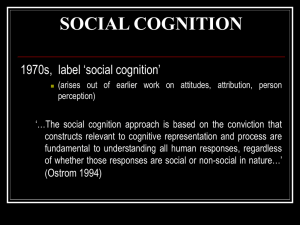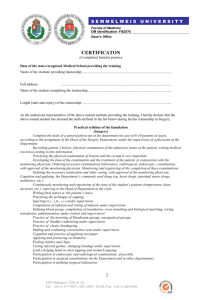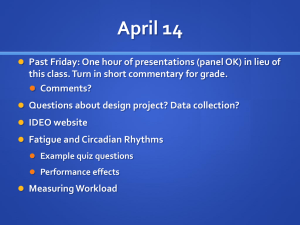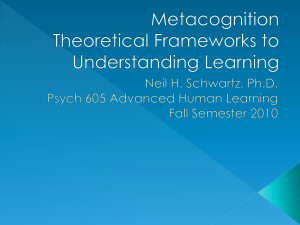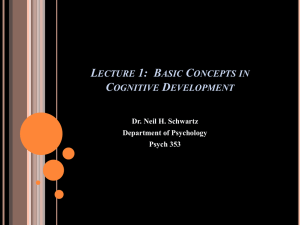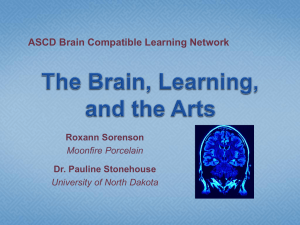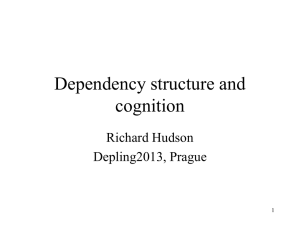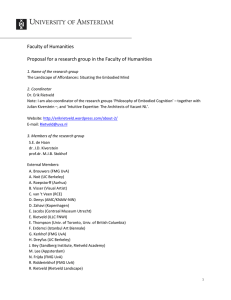Social Cognition and Development
advertisement
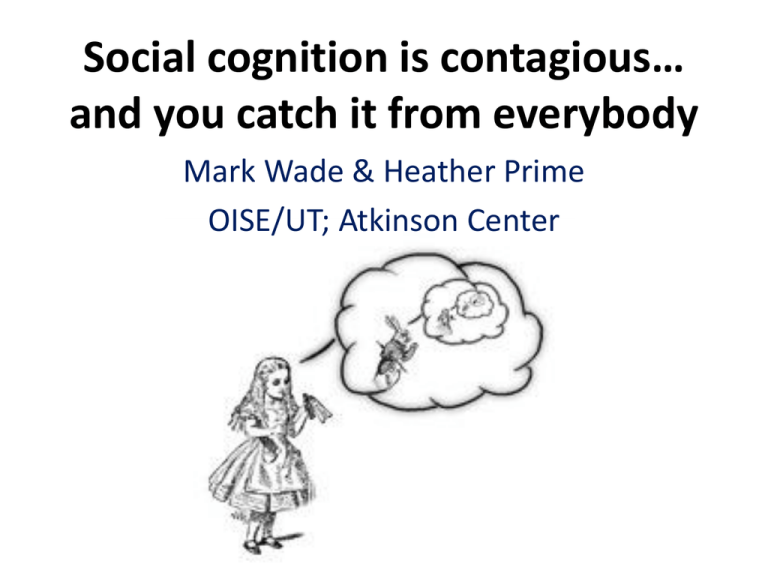
Social cognition is contagious… and you catch it from everybody Mark Wade & Heather Prime OISE/UT; Atkinson Center What is Social Cognition? • It is the ability to understand why people act the way they do. • Includes an awareness that others’ behaviour is driven by internal states: beliefs, desires, intentions, emotions. • The cognitive processes that support children’s engagement in social activities. Social Cognition Includes… 1) A child has an awareness that other people can have subjective experiences that are different from their own (emotions, desires, intentions, etc.). 2) An awareness that they themselves are an objective entity, capable of being the target of others behaviour or mental states. • 3 months: can coordinate vocalizations and facial expressions with others. • 6 months: understand that action is object-directed. • 9 months: can follow the gaze of others, and direct others’ gaze. • 12 months: children can distinguish between accidental and intentional actions. • 15 months: children can use fewer cues to determine goaldirected action (e.g. gaze alone, without pointing). • 18 months: display empathic and cooperative behaviours; joint attention occurs with regularity; pretend play occurs • 2 years • Understand others’ emotions • 3 Years • Understand others’ desires • 4 Years • Understand others’ thoughts, beliefs Development Continuity in Social Cognition Why is Social Cognition Important? • Children with poor social cognition show problems in many areas: – More conflict and communication problems (Dunn & Cutting, 1999) – Lower acceptance among peers (Slaughteret al., 2002) – Lower social skills (Astington, 2003) – More behaviour problems (Hughes & Ensor, 2006) – Less sophisticated academic skills (e.g. language) (Astington & Pelletier, 2005) • Poor theory of mind is considered a core deficit in children with autism (Baron-Cohen et al., 1985). Brain Structures in Social Cognition Anterior cingulate cortex (ACC) (error detection; selfmonitoring; empathy) Temporal-Parietal Cortex (self-other distinction; ToM) Prefrontal cortex (executive functioning; moderating social behaviour) Orbito-frontal cortex (decision-making) Paracingulate cortex (ToM) Amygdala (processing and recognition of emotions) • Rooted in neurocognitive (i.e. brain) development Children at risk for poor social-cognitive development • Children with poor language skills (Astington & Jenkins, 1999) • Children from low socioeconomic backgrounds (Holmes, Black, & Miller, 1996) • Children of parents with low education (Cutting & Dunn, 1999) • Children in single-parent or step families (Amato, 2001) • Children with parents with psychiatric illness (Rohrer et al., 2011) Getting Vygotskian about social cognition • Social origin of individual functioning – Social inputs that afford children opportunities to experience other perspectives towards objects/events will facilitate social understanding • Internalization – External experiences reconstructing internal cognitions – Prior social experiences facilitating future solo activity • Zone of Proximal Development (ZPD) – The difference between what children can achieve in isolation and with expert guidance – Interactions occurring within the child’s ZPD may shape their understanding of mind Parent-child interaction (1) • Activity #1 DVD • Parent-child interaction therapy [videorecording] Washington, DC : American Psychological Association, c2008. See next slide for coding scheme used in present workshop about what to look for in positive parent-child interactions. Atkinson Centre Workshop: Group Activity 1 – Interactive Style of Parents and Caregivers Video #1 Thin Slice Dyad-interaction Coding (Parent-Child) •To answer each of the questions below, think about how it applies to the target person interacting with this specific interaction partner. •Code based on gut reaction; don’t over think any of the items; code quickly. •Use all available information to form a reaction including nonverbals and appearance •Try to use the entire 5-point scale •Do not leave items blank; give each item your best guess 1. 1. 1. 1. 1. 1. 1. 1. 1. 1. Give your impression of how this person would interact with his/her partner on a day-to-day basis, based on what you have seen: This person gives positive nonverbal directions (e.g. pointing, modeling) This person gives negative nonverbal directions. (e.g. grabbing, pulling) This person reminds his/her partner about the ‘big picture’ (e.g. goals / rules of the task). This person is responsive to his/her partner’s request for help, even those that are subtle and/or nonverbal. This person provides age-appropriate verbal labels and/or explanations for what is happening This person is attuned to his/her partner (e.g. imitation, shared affect) When this person’s partner does something that he/she does not agree with, he/she is likely to give negative feedback (criticism, irritation). This person makes enthusiastic comments on his/her partner's achievements during play This person performs behaviours or makes statements in order to encourage his/her child to perform actions by themselves This person assists their child in problem-solving in situations that are above their ability (Not at all true) 1 1 1 1 1 1 1 1 1 1 (Very True) 2 5 2 5 2 5 2 5 3 4 3 4 3 4 3 4 2 5 2 5 2 5 3 4 3 4 3 4 2 5 2 5 3 4 3 4 2 5 3 4 Caregiver influences on social cognition • What caregivers do (offering perspectives) – Sensitivity • Promoting autonomy • Facilitation • Open-ended questions / Explanations – WarmthMutualityInternalization of perspectives • What caregivers say (linking mental states to behaviour) – Mental state language – helping children understand behaviour in terms of mental states • Cognitive: Think, know, believe • Desire: want, hope, wish, care • Feeling: sad, hurt, angry, happy, excited, dislike, etc. Parent-child Interaction (2) http://www.youtube.com/watch?v=rnrPEpMcxqs • Use the same coding scheme from the last interaction for this interaction given what was learned in the previous section. • What are some of the key differences in the way caregivers interact? How might this facilitate social cognition? Additional social influences • Siblings – More siblings related to enhanced social cognition • Exposure to multiple perspectives • Exposure to mental state language from/to siblings • Peers – Peers provide exposure to a diverse group of children – Heightened opportunity for conflict, exclusion, cooperation, play Teacher/Classroom • Teacher can be another mutuallyresponsive partner • Possibility for formalized lessons to facilitate the development of social cognition within this classroom • Exercise Classroom video: group problemsolving exercise http://www.youtube.com/v/GoR_zb5A65E Atkinson Centre Workshop: Group Activity 2 – Interactive Style of Parents and Caregivers Task: In small groups, develop a potential lesson plan or skill-building session that could be easily implemented in the classroom which focuses on developing children’s early social cognition. To assist you, recall that the keys to facilitating social cognition are: (1) providing alternative perspectives and orientations towards objects or events in the environment which can then be internalized; and (2) helping children understand the relationship between behaviour and internal mental states. Target Behaviour or Ability: What is the key behaviour or ability that you are aiming to improve? Why? Target Audience: With whom can/should this technique be used (whole class, small groups, individual students; younger or older children; socially disadvantaged or advantaged children, etc.). What is the basis of the skill-building/lesson plan? (i.e. what is the general process through which the target behaviour/skill/ability can be expected to have a positive effect?) What is the process of implementation? (i.e. outline the steps that you, as the educator(s), would follow to meet your learning goals?) How would you evaluate the effectiveness of this program?
